Poland’s birth rate has dropped to its lowest level since World War II, raising concerns about the country’s demographic and economic future.
Newsweek reached out to the Polish Statistics Bureau (GUS) via email on Wednesday.
Why It Matters
The declining birth rate in Poland, along with a steady rate of deaths, means that the country’s population is shrinking. This could have major long-term impacts on its workforce and economy.
What to Know
Poland registered only 18,500 births in November 2024, newspaper Puls Biznesu reported. The previous low was in June 2024, when 19,000 births were recorded.
The paper wrote that these figures were “the lowest monthly rate since at least the Second World War.”
The number of deaths in Poland has remained relatively stable, and as a result the country’s population is declining.
Poland’s population was 36.8 million in 2023, according to Eurostat, the EU‘s statistical agency, which has gone down by 1.5 million in the last 20 years. Eurostat previously predicted that Poland’s population could drop to around 29.5 million by 2100.

A file photo showing babies in a hospital.
A file photo showing babies in a hospital.
The declining birth rate, along with an aging population, could result in labour shortages and pressures on the country’s pension and health-care systems.
Poland has introduced some financial incentives in recent years to encourage people to have children, including the 500+ program which gives benefits to families with children. But the European Anti-Poverty Network said last year that these measures had not succeeded in raising the birth rate.
Poland’s issues reflect a wider problem throughout Europe. In 2022, the European Union‘s birth rate was at 1.46 live births per woman, compared with a global rate of 2.2. Poland’s was even lower, at 1.29.
In order to maintain its population, a country needs to have a birth rate of 2.1.
The declining birth rate and drop in the working age population could lead to Poland taking in more immigrants. The country’s population received a small boost in recent years from Ukrainian refugees fleeing the war.
What People Are Saying
Eurostat previously said: “In recent decades, Europeans have generally been having fewer children, and this pattern partly explains the slowdown in the EU’s population growth.”
“A total fertility rate of around 2.1 live births per woman is considered to be the replacement level in developed countries: in other words, the average number of live births per woman required to keep the population size constant in the absence of migration.”
What Happens Next
Poland is likely to continue trying to raise the birth rate through financial incentives. It may also allow more immigrants to come to the country to bolster its working age population.
